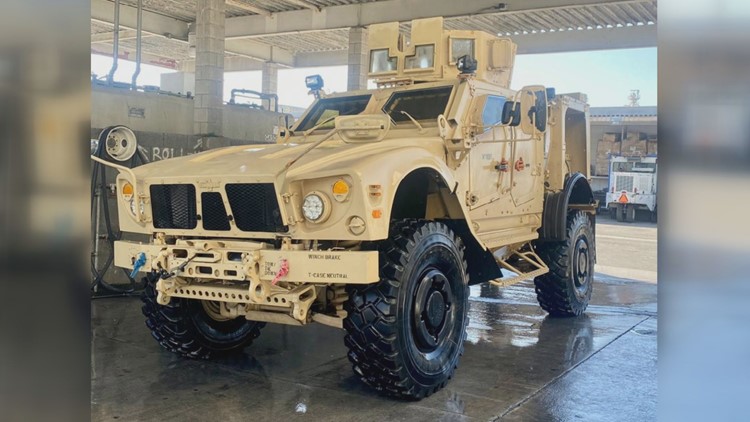AUBURN, Calif. — The Auburn Police Department will soon be getting a Mine-Resistant Ambush-Protected (MRAP) All-Terrain Vehicle from the California Office of Emergency Services.
Auburn city council members approved the transfer this week, as part of what’s been called the 1033 Program through the National Defense Authorization Act. Authorized by Congress in the 90s, the program allows for the transfer of excess U.S. Department of Defense equipment to federal, state, and local agencies.
Here in California, it’s administered through Cal OES’ Law Enforcement Support Program.
On Monday, Auburn city council members gave their unanimous blessing for the Auburn Police Department to receive a 2014 Oshkosh Mine-Resistant Ambush-Protected (MRAP) All-Terrain Vehicle. It comes at no cost to the city.
Auburn Police Chief Ryan Kinnan told council members this will help his department better protect people.
“Here in the Auburn Police Department, we currently do not have an armored rescue vehicle,” he explained. “There are two in the region – one is housed in Roseville and the other is the Placer County Sheriff’s Office. That being said, although we can request those items, as part of a mutual aid agreement, when we need them, the timeliness of them getting here isn’t as quick as we would need them for some type of rescue operation.”
In recent years, however, there has been a discussion – especially in the wake of law enforcement responses to demonstrators following the murder of George Floyd by a Minneapolis police officer - about concerns over the militarization of local law enforcement agencies.
San Francisco City Attorney and former Assembly member (D-San Francisco) David Chiu had that same concern.
“We know that the streets of California are not war zones, our citizens are not enemy combatants. Our police are not military generals,” Chiu told ABC10.
He is now San Francisco City Attorney, but last year he was the Assembly member who authored AB 481, which Gov. Newsom signed into law in September. Starting this year, it requires all police departments and sheriff’s offices in the state of California to establish – and get approved by their local governing bodies – a military equipment use policy.
“Part of why this issue came up was, a number of years ago when we had a lot of protests, there were a lot of surprises from the public when there were some police agencies that were shooting tear gas from military grenade-launchers at peaceful protesters, who were shooting rubber bullets from behind armored vehicles,” Chiu said. “These questions arose, and we want to make sure that we continue to build that trust between police agencies and their local communities.”
At the same city council meeting where he made his case for an MRAP all-terrain vehicle, Auburn’s Chief Kinnan also presented his department’s recently drafted Military Equipment Use Policy.
“The goal of this policy and legislation really was to be a little bit more transparent about what [the] equipment is,” Kinnan said. “This is just going before the public and giving the public and our governing bodies an opportunity to learn more about the process and why we may need this equipment.”
He detailed the military-grade equipment the Auburn Police Department owns —and the situations in which they use it. That presentation starts on page 26 of this city council document.
“Here’s a pepper ball,” Kinnan explained. “You can use this in a crowd management tool, involving barricaded subjects. Only authorized to be deployed by an incident commander after an unruly crowd has committed felonious criminal offenses and refuses to comply with a lawful dispersal order - or incidents in which a subject has committed a crime, barricades him- or herself, and negotiations have failed.”
He said all of the military gear the department has is necessary.
“The reality is, more and more suspects are equipping themselves with not only equipment such as this but also the body armor that is readily available,” Kinnan said.
ABC10 went to ask Auburn residents what they think about whether they think it’s a good idea the Auburn Police Department is getting an armored military vehicle.
Juli Clark said, "I’m actually on board with it…I like the safety aspect of it, definitely," though Clark - a mental health professional - added, "I think it would be helpful for more officers to be informed about mental health issues when they're responding to situations."
Mark Gibson, a lifelong Auburn resident, said, “It’s a little bit too much military equipment. I don’t see the need for it in the city of Auburn. I don’t see that much crime calling for it.”
As part of AB 481, local law enforcement agencies have to prepare an annual report about their use of military equipment in the previous year and whether they will ask to buy more in the coming year — and present that to their local governing bodies.
"I can see them asking, 'How are you using it? Is it a necessity? Can we deploy it somewhere else where it might be better used?'" Gibson said, of AB 481's oversight and transparency.
"I definitely like the transparency," Clark said.
The law enforcement agencies required to create a military equipment use policy include police departments, sheriff's offices, district attorney's offices, county probation departments and the California Department of Corrections and Rehabilitation. Among agencies not included are the California Highway Patrol, the California National Guard and Cal Fire.
If you’re curious about your local law enforcement agency’s military equipment use policy, you should be able to look it up now. State law required departments to have a policy presented to their local governing bodies by May 1.
Here are several local law enforcement agencies’ military use policies:
Editor's Note: The original story incorrectly said the California Department of Corrections and Rehabilitation is not included in AB 481's requirement to create a military equipment use policy. ABC10 has updated the story to reflect that CDCR does, indeed, have to create such a policy - and has done so here.



















